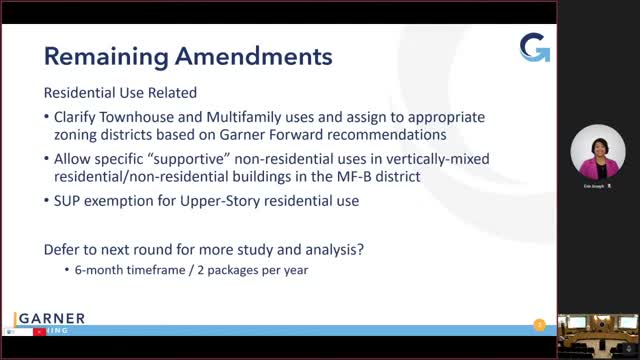Council debates bold changes to residential zoning laws
July 31, 2024 | Garner, Wake County, North Carolina

This article was created by AI summarizing key points discussed. AI makes mistakes, so for full details and context, please refer to the video of the full meeting. Please report any errors so we can fix them. Report an error »

During a recent government meeting, officials discussed significant amendments related to residential zoning and mixed-use development, highlighting the need for clarity in the classification of townhouse and multifamily uses. The conversation centered on aligning these classifications with the comprehensive plan, which has evolved since the rewrite of the Unified Development Ordinance (UDO).
One key topic was the Multifamily Business (MFB) district, which currently lacks provisions for supporting commercial and office uses alongside residential units. Officials expressed a desire to encourage vertical mixed-use developments, where residential units could be situated above commercial spaces. However, the existing zoning framework complicates this integration, particularly for mid-rise developments that do not fit neatly into current zoning categories.
The discussion also touched on the potential for exemptions for upper-story residential uses, with officials considering how to incentivize such developments without creating an unlimited exemption that could lead to overdevelopment. The need for a targeted approach was emphasized, particularly for mid-rise projects that fill a gap in the current zoning landscape.
Additionally, the meeting addressed the integration of commercial uses within residential developments, particularly along major corridors. Officials noted a growing interest in vertical mixed-use projects, where commercial spaces could occupy the ground floor with residential units above. This approach aims to create vibrant, walkable neighborhoods that support both living and working environments.
On the non-residential side, the meeting highlighted proposals to establish research and development as a distinct use category, separate from light industrial classifications. This change would allow for clearer standards and facilitate the inclusion of such uses in various zoning districts. The discussion also included the potential addition of hospitals and financial institutions to the activity center zoning district, with considerations for their integration into mixed-use developments.
Overall, the meeting underscored the importance of a holistic approach to zoning that accommodates both residential and commercial needs, ensuring that future developments align with the community's vision for growth and sustainability. Officials expressed a commitment to revisiting these discussions in future meetings, aiming to refine the zoning framework to better serve the evolving needs of the community.
One key topic was the Multifamily Business (MFB) district, which currently lacks provisions for supporting commercial and office uses alongside residential units. Officials expressed a desire to encourage vertical mixed-use developments, where residential units could be situated above commercial spaces. However, the existing zoning framework complicates this integration, particularly for mid-rise developments that do not fit neatly into current zoning categories.
The discussion also touched on the potential for exemptions for upper-story residential uses, with officials considering how to incentivize such developments without creating an unlimited exemption that could lead to overdevelopment. The need for a targeted approach was emphasized, particularly for mid-rise projects that fill a gap in the current zoning landscape.
Additionally, the meeting addressed the integration of commercial uses within residential developments, particularly along major corridors. Officials noted a growing interest in vertical mixed-use projects, where commercial spaces could occupy the ground floor with residential units above. This approach aims to create vibrant, walkable neighborhoods that support both living and working environments.
On the non-residential side, the meeting highlighted proposals to establish research and development as a distinct use category, separate from light industrial classifications. This change would allow for clearer standards and facilitate the inclusion of such uses in various zoning districts. The discussion also included the potential addition of hospitals and financial institutions to the activity center zoning district, with considerations for their integration into mixed-use developments.
Overall, the meeting underscored the importance of a holistic approach to zoning that accommodates both residential and commercial needs, ensuring that future developments align with the community's vision for growth and sustainability. Officials expressed a commitment to revisiting these discussions in future meetings, aiming to refine the zoning framework to better serve the evolving needs of the community.
View full meeting
This article is based on a recent meeting—watch the full video and explore the complete transcript for deeper insights into the discussion.
View full meeting
